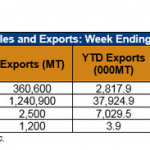Lesser Prairie Chicken Removed from Endangered Species List –The U.S. Fish and Wildlife Service officially removed the lesser prairie chicken from the Federal List of Endangered and Threatened Wildlife in a final rule published on Wednesday, July 20. The action follows a court order ruling that vacated the species’ listing under the Endangered Species Act. While the delisting is a short-term victory for landowners, the action from the agency does not constitute a biological determination on whether the bird warrants federal protection. As a result, the agency announced it will undertake a re-evaluation of the bird’s status relative to a five-state conservation program to determine whether ESA listing is still necessary.
In the coming weeks we will take a closer look at research projects approved for funding by the TGSP board of directors. These projects are currently taking place and final results should be available by January 2017. If you have further questions regarding studies, please reach out to Katelyn Luckett, katelyn@texassorghum.org.
TGSP Approves BMP/Yield Research Study—Demonstrating Grain Sorghum Potential in Texas: Using Best Management Practices to Maximize Yield and Economic Return; Principal Investigator: Ronnie Schnell—Grain sorghum yields overall in Texas have not increased much since the 1970’s. Yet, statewide data does not accurately describe sorghum potential in Texas. Using actual yield measurements from AgriLife trials, yield trends have not been equal across the state. Large yield increases (1.6 bu/acre/yr) have been observed in the High Plains region under irrigation while other regions have had little if any increase in yield. National Sorghum Yield Contest and other yield reports from regions with lower yield trends suggest that much greater yield potential does exist. Greater than 200 bu/acre was obtained in central Texas during 2014 while many growers are content with less than 100 bu/acre. This study will use demonstration/ research plots within major sorghum production regions of Texas to compare current and common farmer practices to high input production systems with corresponding higher yield goals. The goal is to determine the true genetic and environmental limits to grain sorghum by production region. Yield potential and associated inputs will be weighed against economic return to optimize yield goals and recommendations.
Market Perspectives—Sorghum: Net sales of 53,500 MT for 2015/2016 were up 25 percent from the previous week, but down 39 percent from the prior 4-week average. Increases were reported for China (28,000 MT), Colombia (25,000 MT), and Indonesia (500 MT). Exports of 2,500 MT were down 98 percent from the previous week and 96 percent from the prior 4-week average. The destination was Mexico. To read the entire Market Perspectives, provided by the US Grains Council, click here.
Comment Today on Need for Atrazine, Propazine—Atrazine and propazine are under attack by the Environmental Protection Agency. Despite science-based regulations demonstrating the safety of these chemicals for more than 50 years, the EPA’s hyperactive regulatory machine threatens to render these important crop protection tools useless in controlling weeds on 90 percent of the acres in the U.S. Weigh in on how EPA’s draft Ecological Risk Assessments put farmers at an economic disadvantage and submit your own comments before October 4, 2016, at http://sorghumgrowers.com/sorghumalert.










